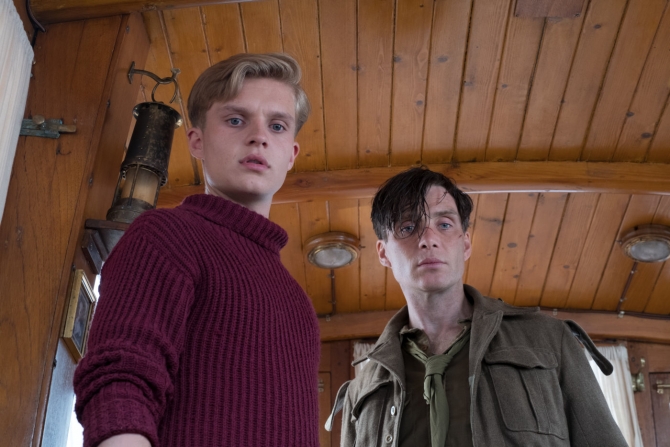NB: This is your final warning for major Dunkirk spoilers.
Although it takes place in one of the most dramatic chapters of World War II, Dunkirk isn’t really about conflict, or violence, or the horrors of combat. It’s really about what ordinary people do in desperate situations, when they’re being assaulted from all sides by the roar of bombs and gunfire.
It’s surely telling that one of the leads among writer-director Christopher Nolan’s ensemble, Ffion Whitehead’s rank-and-file soldier, Tommy, doesn’t get to indulge in the kind of macho heroics that we used to see in the war movies of the 50s and 60s. For much of the film, he’s simply trying to survive, whether it’s by stretchering off a wounded soldier as a pretext for getting on one of the ships evacuating troops from the beach, or hiding under a jetty as bombs rain down from above. (Nolan also commendably casts young 20-somethings as the soldiers – a stark contrast to The Longest Day, in which the 55-year-old John Wayne was almost twice as old as the American colonel he was asked to play.)
The more obviously heroic characters in Dunkirk can be found at sea and in the air. Having established that hundreds of thousands of Allied troops are trapped on the French coast by an advancing German army, Nolan illustrates the rescue attempt through Mark Rylance’s Dawson – one of dozens of civilian mariners who used their tiny boats to help the evacuation effort – and Tom Hardy’s Farrier, one of many pilots who provided aerial support. But even with these characters, who provide an intimate perspective on a huge operation, Nolan’s careful not to give them grand speeches or moments of punch-the-air heroism. They simply get on with the task at hand; Dawson steering his little boat across the sea and picking up survivors along the way (the first of them being Cillian Murphy’s traumatised soldier), Farrier coolly fending off attacks from German fighters and bombers.
Even these characters’ moments of self-sacrifice are served up with a quintessentially British sense of understatement. In Dunkirk’s dramatic conclusion, Dawson chooses to press on with his mission, arrives at the French extraction point, and lets as many soldiers aboard as his boat will allow. Note how Dawson and his son Peter (Tom Glynn-Carney) swallow their anger at the accidental death of their young friend George (Barry Keoghan) rather than traumatise Murphy’s character any further. There’s an unspoken understanding between father and son, perhaps, that while George’s death was tragically avoidable, there’s no time for guilt or blame – the war effort has to take priority.
Of all the characters in Dunkirk, Tom Hardy’s Farrier makes perhaps the greatest sacrifice of all. It was established near the beginning that the fuel gauge was damaged by an enemy bullet; despite this, he limps on, with only a vague idea of how much time in the air he has before the engine cuts out. As soldiers pour onto the flotilla of small vessels lining up on the beach, Farrier, now effectively gliding with no juice left in the tank, uses his last precious few minutes in the air to head off a potentially deadly assault from an enemy fighter.
While the scenes of soldiers landing back in Britain are moving in themselves, as Harry Styles’ Alex nervously wonders whether they’ll be condemned as cowards for withdrawing from mainland Europe, it’s the last moments of Farrier’s story that, for this writer, are the most poignant. Rather than bring his Spitfire in for a rough landing on the sea, Farrier instead lowers the landing gear and lands his plane tenderly on the now deserted Dunkirk beach. With all hope of joining the extraction now gone, he’s left with no choice but to fire a flare into the Spitfire’s cockpit; better to put his old friend to sleep than let it fall into enemy hands.

Remaining true to his own apparent goal of keeping German soldiers out of the picture, Nolan films Farrier’s capture largely in close-up; we see the soldiers approach, but they’re largely out of focus, their faces shaded by the warm light of a setting sun.
Farrier’s precise fate is left to our imaginations, but we know from real-life accounts that, while some 340,000 British and French troops were rescued during the “Miracle of Dunkirk”, some 40,000 were left behind. It’s all but certain, then, that Farrier would have joined those thousands of prisoners of war, who were marched hundreds of miles to camps in Poland and Germany. There, they were commonly forced to work in factories or fields, and frequently beaten, starved, or even killed.

As a piece of cinema, Dunkirk is almost overwhelming in its use of sound and editing – it’s undoubtedly Nolan’s most assaultive, intense film to date. But while the sight of tiny boats carrying exhausted, shell-shocked troops to safety, and the words of Winston Churchill’s famous “We shall fight on the beaches” speech provide uplift, Dunkirk’s ending also highlights what was lost along the way.
Had Dawson and his son abandoned their mission and turned back, George’s life might – just might – have been saved. Had Farrier landed his plane rather than go round for another pass at that German fighter, other troops might have died, but he might also have managed to grab a lift on one of those rescue boats. Nolan’s final shots of the burning Spitfire, and Farrier’s stoic face as he’s led away, are a potent, unforgettable reminder of the sacrifices that had to be made to make the Miracle of Dunkirk happen.

